![Rio3[1].jpg (76446 bytes)](images/Rio3[1].jpg)

Peru (2003)
The Lost City of the Incas
Inspired by a trip that Valerie’s mother, a world traveler in her own right, took to Machu Picchu over forty years ago, the Lost City of the Incas has long been one of our travel destination dreams. By combining a visit to Machu Picchu with a week-long river boat journey through the jungles of the Upper Amazon, our trip to Peru was one of our most exciting travel adventures ever.
![Rio3[1].jpg (76446 bytes)](images/Rio3[1].jpg) |
 |
M/S Rio Amazones Piranha Fish
Amazon River. Following a one day stopover in Lima, the capital city of Peru, we took a ninety minute flight the next morning over the snow-crested Andes Mountains and out over the steaming, green Amazonian jungle. Two-thirds of the way into our flight, we had our first glimpse of the mighty Amazon River below, snaking its way through the endless rainforest.
Although about two hundred miles shorter than the Nile, the Amazon River is the world’s largest river by any other measure. Collecting the rainfall from the world’s largest rain forest area, the water flow at its mouth is greater than the Mississippi, the Nile, the Congo, the Yangtze and the next five world’s largest rivers combined. One day’s discharge at its two hundred mile wide river mouth could supply all the households in the U.S. with their water needs for more than five months. In fact, the flow is so powerful that its muddy discharge can be spotted as far as two hundred miles out in the Atlantic Ocean.
Our plane landed at Iquitos, the only city of any size in a region as big as Texas. Totally inaccessible by road, Iquitos was once a flourishing river town during the era of the rubber boom in the 1880’s. It is now a sprawling and murky river town of 175,000 people accessible only by air or boat. Located 1700 miles from the headwaters of the Amazon, high in the Andes, and 2300 miles from the river’s exit into the Atlantic Ocean, Iquitos is an important river port for the region.
It was in Iquitos that we boarded the M/S Rio Amazonas for our week long cruise through the jungles of the upper Amazon. The Rio Amazonas was built in Scotland in 1896 and has been working on the Amazon River for over 100 years first as a cargo ship and then as a passenger river boat. Although the Amazonas has more in common with the African Queen than the Queen Elisabeth, this venerable old, three-decked river boat turned out to be quite comfortable in a funky sort of way. It carried a crew of sixteen and, although it had a capacity for forty-four passengers, there were only ten of us on the trip downstream and five on the return. Although this post 9/11 drop in tourism has been very hard on the travel industry world-wide, it was great for us and almost like having our own private riverboat. For a week, Val and I were the King and Queen of the Amazon.
Our fellow passengers were amiable . . . three other Nordamericanos, three Latin Americans and two Israelis. The crew was all Amazonian with only one, our naturalist, who spoke any English. The food was good, mostly local fare . . . fish, rice, beans, manioc, plantains and fruit . . . and healthy. Our cruise took us three hundred miles down river to the adjacent border towns of Leticia, Columbia and Tabatinga, Brazil, where we had a morning to go ashore and wander around before returning back upstream to Iquitos.
The pace on the river was slow but our days were filled with shore excursions. The wooden-hulled Rio Amazones has a very shallow draft and can simply pull up along the shore, tie up to a couple of trees on the river bank, drop a gang plank to put its passengers ashore. On other occasions, we boarded a small boat equipped with an outboard motor and traveled up one or more of the small tributaries for our outings. The days often started with early morning bird watching excursions, included a mid-afternoon jungle hike and finished with an after dark caiman hunt, when the alligator-like creatures’ red eyes reflect in the beam of the flashlight, giving away their hiding spots in the reedy shallows. Other highlights were pink dolphin and monkey spotting and piranha fishing plus shore visits to an artist’s jungle home and a leprosy colony.
The most interesting excursions were visits to several isolated Indian villages along the river. The indigenous tribes still live in a very primitive way and the people and their surroundings are like pictures out of National Geographic magazine. We visited the villages of the Bora and the Yagua tribes and these
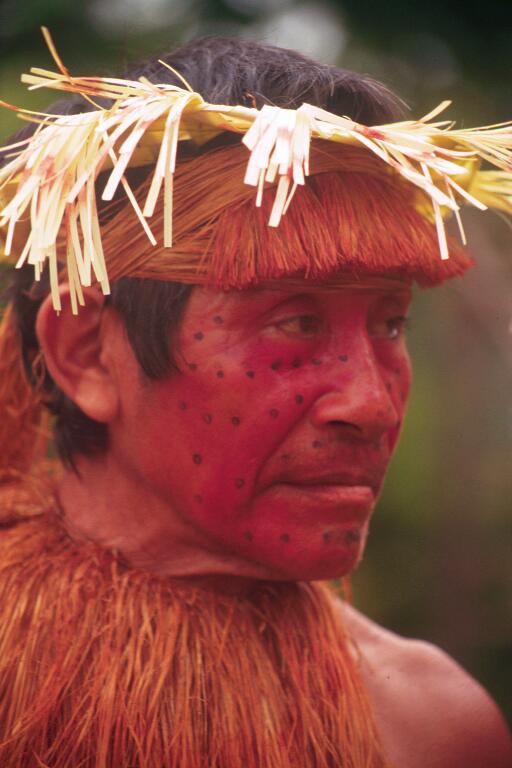 |
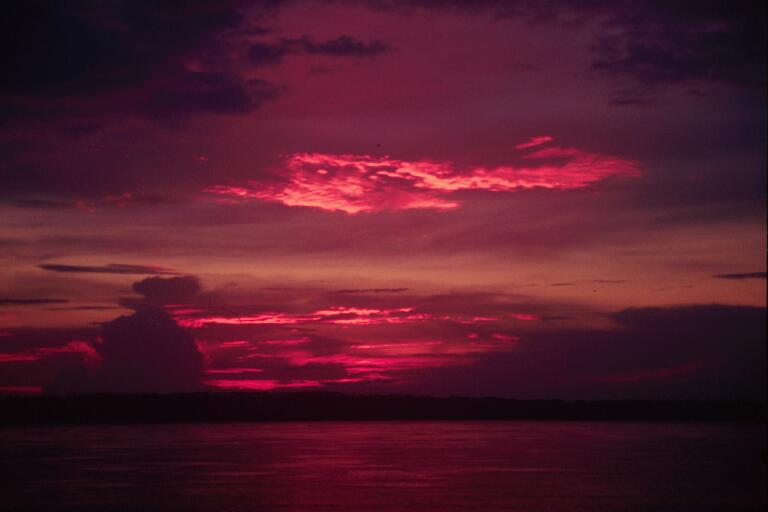 |
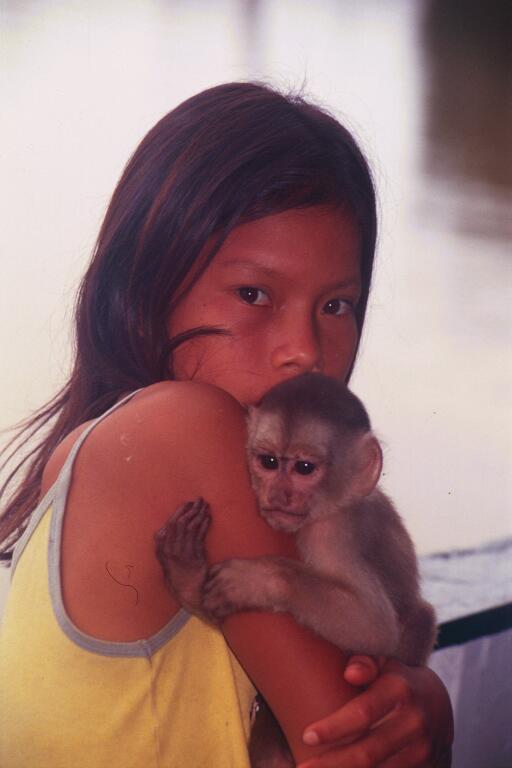 |
Yagua Chieftan Sunset on the Amazon Indian Girl with Monkey
encounters provided some great photo ops as well as a chance to contribute to their local economy by purchasing their handicraft such as dolls, paintings and jewelry. The men still use blowguns to hunt and we were given a demonstration of how to tip the dart with curare and then load and fire it. We were also invited to join with the locals in several of their ceremonial dances. I have never been known to turn down an invitation to dance from a topless woman . . . and particularly when her men folk have just demonstrated deadly accuracy with their blowguns. It was great fun and it’s all recorded for posterity on video tape.
But the strongest memories of the Amazon are simply the times we spend watching the ever changing panorama of the emerald forest passing slowly by from our hammocks or chairs on the sun deck of the Rio Amazones. Often the nicest moments occurred just before sunset. One evening was particularly memorable as Val and I sat alone at the front of the ship drinking our daily pisco sours and watching the sun melt into a red-orange flame and disappear into the darkening green jungle while thousands upon thousands of squawking parakeets filled the sky in their evening migration to their sleeping trees for their night. Once the birds were silent, the tree frogs began their intense chorus of croaking music and the stars emerged in the great black expanse of sky above the river. The sound of the frogs eventually died away and left only the quiet, thrumming of the ship’s ancient diesel engine as we continued to wend our way silently up the river. These were magic moments captured in our memories for a lifetime.
Cusco. Following our week on the Amazon, we flew back to Lima to stay overnight and to exchange our tropical jungle clothes for our warmer mountain clothes in our suitcases and then left again early the next morning for our flight to Cusco, the imperial capital city of the ancient Inca Empire and the gateway to the legendary city of Machu Picchu. Warned about the effects of altitude sickness, we checked into our hotel, drank a cup of mate di coca (coco-leaf tea) and had a quick "toes-up" in our room to allow our bodies to adjust to the 11,200 foot altitude and breath in a little extra oxygen in the only major hotel in the world which has oxygen piped into its guest rooms.
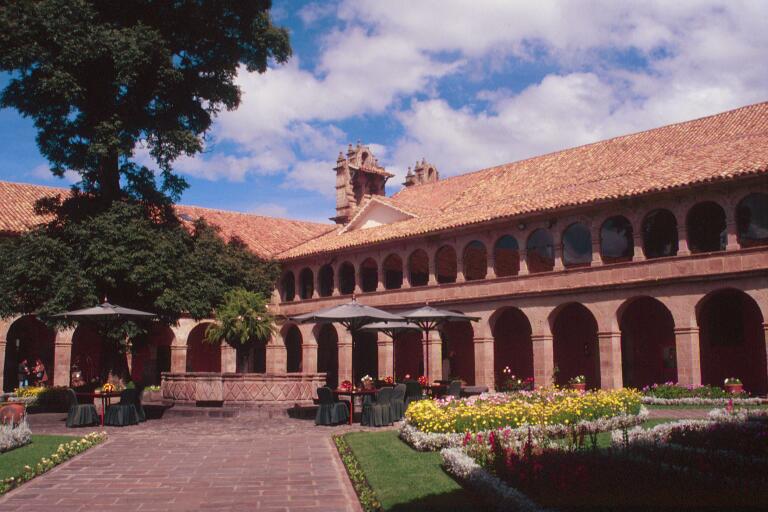 |
.png) |
Hotel Monesterio - Cusco Paul, Val and Friends
Although most tourists come to Cusco as a jump off to Machu Picchu, it is charming city in its own right with its layers of Spanish architecture built on top of the stone foundations of the Incan city. It looks and feels very much like what you would expect of an Andean capital with its fascinating blend of pre-Columbian, colonial and contemporary mestizo culture. Although the early Spanish conquistadors razed most of the Inca buildings and monuments in Cusco, they found many of the structures to be so well engineered that they built their own homes and buildings upon the very foundations of Inca Cusco. It is a source of price to the locals that, while earthquakes have toppled many of the Spanish buildings through the centuries, the Inca constructions have withstood them all.
Our afternoon tour highlighted these layers of history from the Inca ruins, like Sacsayhauman, the massive temple-fortress overlooking the city, to the colonial-era Baroque and Renaissance churches and mansions in the center of town. Following the tour we took a stroll in town through the narrow, stone streets filled with shops with handicrafts of all types and with costumed Andean women and children wandering through the streets with their llamas offering to have their pictures taken by the tourists. We couldn’t resist either.
Our hotel, Monastario, deserves a paragraph of its own as perhaps one of the most magnificent hotels we’ve ever stayed in anywhere in the world. The hotel occupies a 16th century monastery, constructed on the foundations of an Inca palace and was converted into a luxury hotel only in 1995. As much a museum as a hotel, it has an opulent gilded chapel, an magnificent art collection and beautiful courtyards. The bedrooms are elaborately decorated and the buffet breakfast is served to the accompaniment of Gregorian chants. It was a wonderful albeit "big splurge" choice for our three day stay in Cusco and a great place for our introduction to the world of the Incas.
Although the Incas were merely the last in a long line of advanced, pre-Columbian cultures which inhabited Peru, they are certainly the best known of all the early Peruvian cultures . . . even though their power lasted only about one hundred years from the mid-15th to the mid-16th centuries. At the height of its power the Inca Empire extended over 3,500 miles from present day Columbia to Chile, a reach that extended even beyond that of the Roman Empire.
Their achievements were impressive. They constructed over 20,000 miles of roads over harsh, mountainous terrain to connect their cities, farming communities and religious sites. Their agricultural technology was highly advanced and based on remarkably modern irrigation and soil conservation practices. Although lacking any written language, they developed an advanced system of mathematics and accounting using knots on a string as their counting tool. And, of course, the Incas were, perhaps, best known as extraordinary architects and stone-masons, their construction still the subject of awe and amazement even today.
During the time that the Inca Empire was flourishing, the Spanish Conquistadors arrived in the New World in search of gold. Francisco Pizarro lead an expedition into Inca territory and with an unbelievably small number of Spanish troops - only 180 men and 30 horses - managed to capture the Inca emperor, to massacre 5-6,000 Incan warriors and to conquer a nation of several million people. Already weakened by civil wars, the Incas with their slings, battle axes and padded armor proved to be ill-matched against the Spaniards with their steel swords, body armor, cannons and horses. Even so, it is seems incredible that such a small force could have defeated such a large army under any circumstances.
Machu Picchu. The ruins at Machu Picchu are one of the most beautiful and enigmatic sights on earth, sitting majestically among the massive Andes and bathed in a dreamy mist.
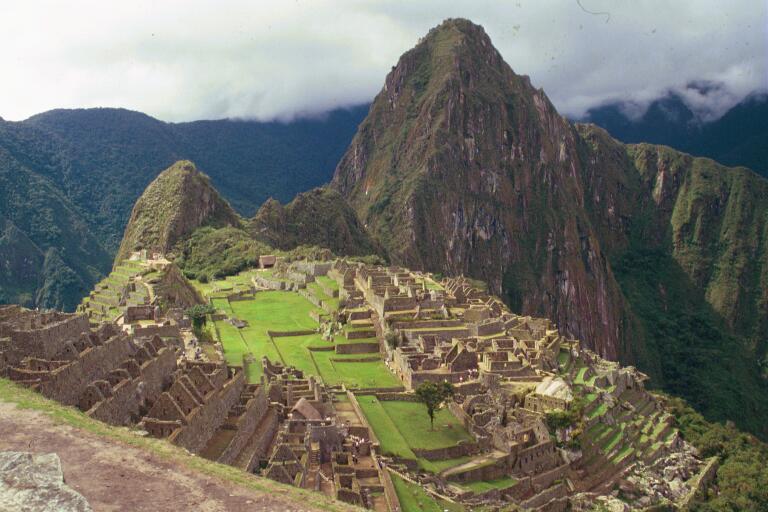 |
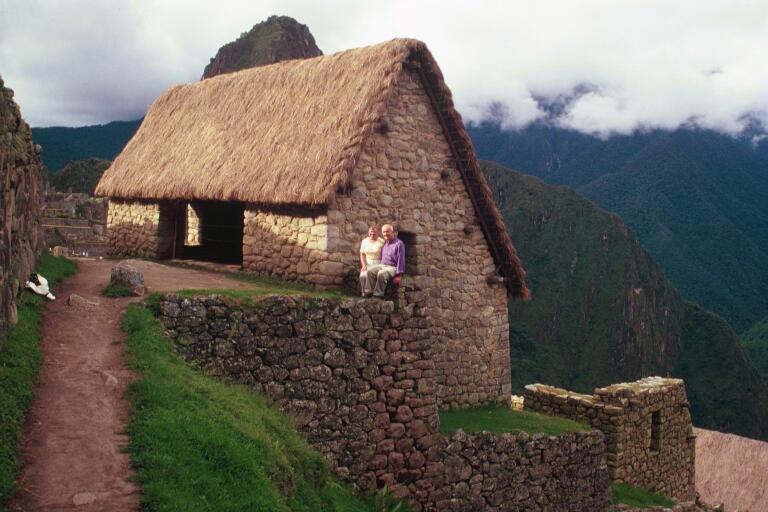 |
Machu Picchu - The Lost City of the Incas The Watchman's Hut
Built between 1460 and 1470 by the great Incan ruler, Pachacion, as a sacred center and royal retreat, the site was abandoned in the 1530ís and was gradually covered over by jungle growth (like the castle in Sleeping Beauty) until discovered in 1911 by Hiram Bingham, a Yale University professor. His articles and photographs captured the imagination of the world and, ever since his discovery, thousands of visitors have been captivated by this magical place.
In Inca times, you would have had to travel for more than a week on the Inca Trail to cover the 65 miles from Cusco to Machu Picchu and, although there are still many hardy souls who chose to hike the Inca Trail to Machu Picchu, we opted for the train. The comfortable, vista-dome train trip takes less than four hours working its way up Picchu Mountain and along the lush valleys of the Urubamba River with spectacular views of the snow-capped Andes at every turn. The final leg to the site was a bus ride up a narrow and precipitous dirt road best taken with one’s eye’s tight shut.
Although we’ve seen hundreds of photographs of Machu Picchu, there are truly no pictures that can do it full justice and our first view of the ruins is a sight which will be etched in our memory forever. The ancient city is built on a ridge between Machu Picchu Mountain and Huayna Picchu Mountain at an elevation of 8,000 feet. The narrow ridge drops off steeply on both sides for about 2,000 feet to the Urubamba River below, which circles the site on three sides and eventually joins the Amazon. Invisible from below and completely self-sufficient with its own agricultural terraces and water supply, Machu Picchu remained undetected by the Spanish invaders and has survived virtually intact to the present day.
Upon arrival, we took a three hour, walking tour of the site in the afternoon. Machu Picchu is made up of approximately two hundred buildings. Most are residences although there are temples, storage structures and other public buildings. The houses had steep thatched roofs and trapezoidal doors; windows were unusual. At the center each group of houses were communal courtyards. Livestock enclosures and terraces for growing maize and potatoes stretched around the edge of the city.
About 1,200 people lived in and around Machu Picchu. The buildings were planned and built under the supervision of highly skilled Inca architects and were constructed of granite blocks cut with bronze or stone tools and smoothed with sand. The massive blocks fit together perfectly without mortar, even though none of the blocks are the same size and some have as many as thirty faces. The joints are so tight that even the thinnest of knife blades can’t be forced between the stones. Although some of the stone work at the site has been restored, two-thirds of the buildings remain exactly as they stood in ancient Inca times, a remarkable tribute to their skill as builders.
One of the more interesting constructions found a Machu Picchu in the intihuatana, meaning hitching post, which is a stone column rising from a block of stone about the size of a grand piano. As the winter solstice approached and the sun appeared to disappear a little more each day, a priest would hold a ceremony to ‘tie the sun to the stone’ to prevent it from disappearing altogether. Not surprisingly, it did the job every year and sun never did disappear.
Having made our reservations many months earlier, we were among a limited number of tourists privileged to stay at the site overnight. Although the thirty room Machu Picchu Sanctuary Lodge is decried by some as an unwanted intrusion onto the sanctity of the site, it did leave those of us who stayed there with a wonderful sense of solitude after the tourist buses left for the valley in late afternoon and before they returned at mid-morning the next day. We had hoped to return to the ruins at night under the light of the full moon but, unfortunately, the clouds descended in the evening and obscured the site. We did, however, take two, long daytime hikes, one to the Inca Bridge, which guarded the rear access to the site and the second to the Sun Gate, high above the ancient city, from which hikers of the Inca trail, both the ancient Incas and modern backpackers, have their first panoramic view of the magnificent Lost City of the Incas down below.
We had planned a third leg of our itinerary to Lake Titicaca on the border of Peru and Bolivia and on to Le Paz, Bolivia’s capital city. Unfortunately, we heard some disturbing news reports about rioting and armed clashes in La Paz and, checking with our state department travel advisory web page on the internet, learned that U.S. citizens were being urged to delay any travel into that country. Although we were disappointed to cut out our visit to Bolivia and return to the U.S. a few days earlier than planned, our week in the Amazon and second week in the Andes were always the unquestioned highlights of our trip.